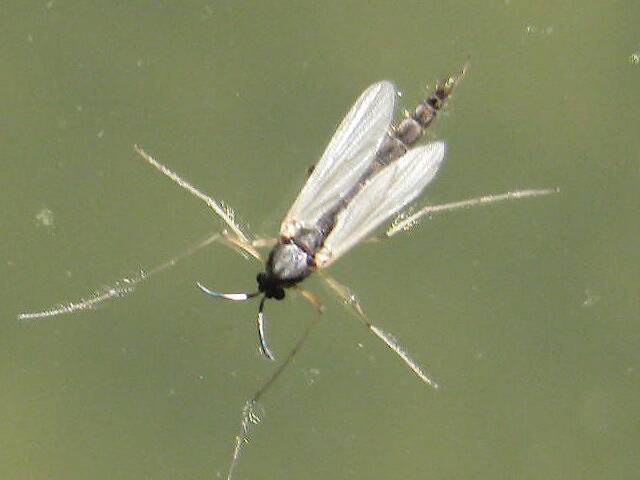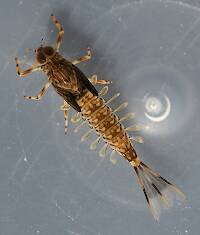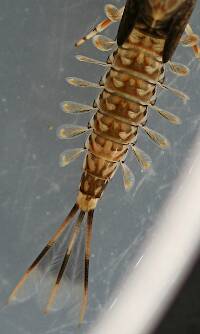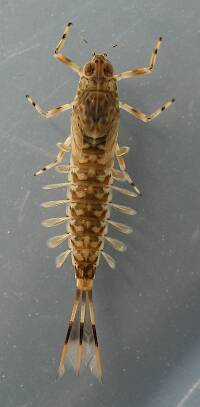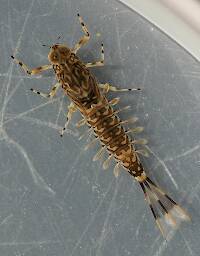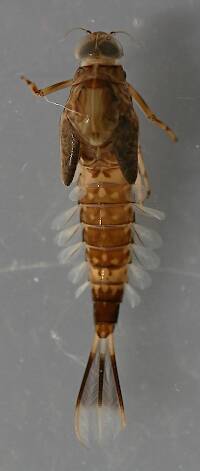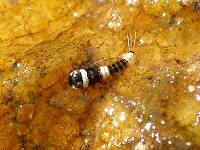
Salmonflies
Pteronarcys californica
The giant Salmonflies of the Western mountains are legendary for their proclivity to elicit consistent dry-fly action and ferocious strikes.
Featured on the forum

This one seems to tentatively key to Holocentropus, although I can't make out the anal spines in Couplet 7 of the Key to Genera of Polycentropodidae Larvae nor the dark bands in Couplet 4 of the Key to Genera of Polycentropodidae Larvae, making me wonder if I went wrong somewhere in keying it out. I don't see where that could have happened, though. It might also be that it's a very immature larva and doesn't possess all the identifying characteristics in the key yet. If Holocentropus is correct, then Holocentropus flavus and Holocentropus interruptus are the two likely possibilities based on range, but I was not able to find a description of their larvae.

Troutnut is a project started in 2003 by salmonid ecologist Jason "Troutnut" Neuswanger to help anglers and
fly tyers unabashedly embrace the entomological side of the sport. Learn more about Troutnut or
support the project for an enhanced experience here.
Konchu on May 9, 2014May 9th, 2014, 10:06 am EDT
Interesting article about Didymo in New Zealand & elsewhere
http://www.nzherald.co.nz/jamie-morton/news/article.cfm?a_id=729&objectid=11252518
http://www.nzherald.co.nz/jamie-morton/news/article.cfm?a_id=729&objectid=11252518
Falsifly on May 9, 2014May 9th, 2014, 12:38 pm EDT
Ah! The dreaded, “climate change and other human-caused environmental changes” and the “ever-increasing international travel” will be the fall of us all. To think that life has evolved and adapted for eons only to finally succumb to global destruction at the hands of mankind leaves me saddened that my short visit was, in the greater scheme of things, part of its demise.
However, in the case of New Zealand my legal obligation to “strict biosecurity rules” has been met and I claim complete immunity.
As to the question of “spread?”. It wasn’t me, I will use the “absence of evidence” that I ever stepped foot in New Zealand as my “evidence of absence”.
The so-called "rock snot" has not yet been found in North Island rivers and under strict biosecurity rules, people are legally obliged to prevent spreading it.
However, in the case of New Zealand my legal obligation to “strict biosecurity rules” has been met and I claim complete immunity.
The paper's lead author, Professor Brad Taylor, said didymo blooms were hastily attributed to human introductions or the emergence of new genetic strain because the absence of evidence was used as evidence of absence in many locations.
As to the question of “spread?”. It wasn’t me, I will use the “absence of evidence” that I ever stepped foot in New Zealand as my “evidence of absence”.
Falsifly
When asked what I just caught that monster on I showed him. He put on his magnifiers and said, "I can't believe they can see that."
When asked what I just caught that monster on I showed him. He put on his magnifiers and said, "I can't believe they can see that."
Quick Reply
Related Discussions
Topic
Replies
Last Reply
0
May 6, 2012
by Jesse
by Jesse
Re: Possible Didymo in the East Branch of the Delaware
In The East Branch of the Delaware River by Softhackle
In The East Branch of the Delaware River by Softhackle
12
Jul 15, 2015
by AFISHN
by AFISHN



